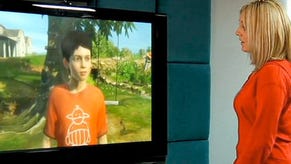E3: Molyneux and Milo
A chat with Peter and his new best friend.
The last time Eurogamer met up with Peter Molyneux was at the Game Developers Conference in March. Back then the Lionhead boss teased us with talk of his next project but wouldn't reveal any details, stating, "I will absolutely not talk about anything, any concepts or ideas, until I've got something tangible to show."
Luckily he had something tangible to show in time for Microsoft's E3 press conference. Yesterday Molyneux introduced us to a walking, talking virtual boy called Milo, and showed how we can interact with his world. It was a highly impressive demo, but one that raised more questions than it answered.
So Eurogamer sat down with Molyneux to find out more about the history of Milo's development and Lionhead's efforts to push the boundaries of artificial intelligence. And more importantly, to ask him some facetious questions about nobs, bras and dogs. Read on to find out what he had to say.
There are two answers to that. We started work with the Natal stuff in December, and the first thing we did was go round all the Microsoft people - the handwriting recognition people, the facial recognition people, the motion recognition people. We brought the technology together and put it in there.
So the world you see created here has been in development since December. Before that, we'd been working on this thing called emotional AI since we finished the first Black and White.
Yes.
A lot of stuff, like the voice recognition stuff, is based on things like Windows 7 technology. We just went round and took all that stuff and fitted it together. The interesting thing is, a lot of that stuff existed without reason - and when you bring it all together with something like this, it kind of works.
Milo can recognise the emotions on your face and the emotions in your voice. He can recognise certain words you say. You can have conversations with him, you can read stories to him. We're trying to bring all these things together. Some of them are tricks - I'll be absolutely honest with you - to make you believe Milo's real.
He can recognise what you're wearing. If he notices you've got dark bags under your eyes he will say, 'You look tired today.'
Absolutely, all of that works. We're combining all that together to make you really believe that he understands what you say.
Let's try an experiment. When a human voice says something funny, there's a different tone in the voice. Even though Milo's not trained to recognise your voice, if you say something funny to him, he should recognise it as something amusing. Try it now.
Yeah.

[Looks up, smiles and nods]
[Giggles]
Now, he didn't really understand every word you said, but from the tone of your voice he guessed you were telling a joke.
Well, that wasn't a real laugh. That was a polite giggle. Let's move on. The game is called Milo and Kate and you play through a story. There is another character called Kate. Kate is a dog.
No, it's not a parrot. Milo can recognise your writing - you can write words, write numbers, draw pictures, and put them into his world.










